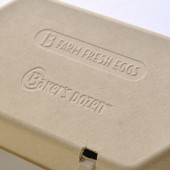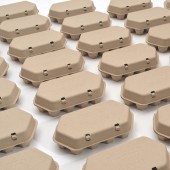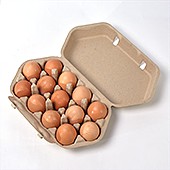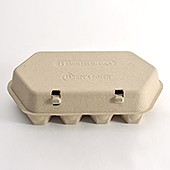
| THE AWARD |
| CATEGORIES |
| REGISTRATION |
| SUBMIT YOUR WORK |
| ENTRY INSTRUCTIONS |
| TERMS & CONDITIONS |
| PUBLICATIONS |
| DATES & FEES |
| METHODOLOGY |
| CONTACT |
| WINNERS |
| PRESS ROOM |
| GET INVOLVED |
| DESIGN PRIZE |
| DESIGN STORE |
| THE AWARD | JURY | CATEGORIES | REGISTRATION | PRESS | WINNERS | PUBLICATIONS | ENTRY INSTRUCTIONS |
Bakers Dozen 13 Pack Egg Carton by Randy Ludacer |
Home > Winners > Design #87428 >Interview |
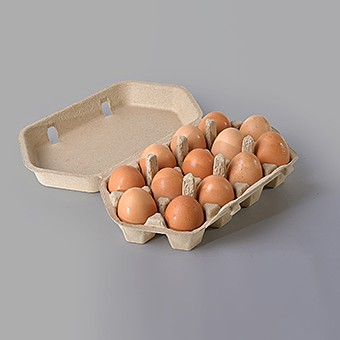 |
|
FS: What is the main principle, idea and inspiration behind your design?
RL: Sometimes making one small change to an existing design seems to change everything. Adding just one more egg to a regular carton of 12 is stupid, of course. Who really needs that one extra egg? Honestly, it’s an unnecessary caprice, so far as "consumer demand" is concerned. But, as an idea, it was something that I just wanted to see. How should the eggs be arranged? What would it look like?
FS: What has been your main focus in designing this work? Especially what did you want to achieve?
RL: Initially, I was focused on the idea that a hexagonal arrangement might be more efficient. I even claimed, at one point that I was fitting more eggs into a smaller area. This turned out to all wrong for a variety of reasons. It was a meaningless calculation, for one thing, offering no practical benefit to a world of rectangular boxes, trucks and supermarket display cases. When faced with the prospect, that this carton was actually going to be manufacture, my focus had to abruptly shift for capricious to practical problem-solving. Exactly how big should the inner egg compartment to gently hold each egg in place? Not too tight, but not so loose that they rattle around inside. Ultimately, we wound up making our egg carton larger than a regular dozer pack, in order to accommodate a wider range of different egg sizes. (Since making Baker’s Dozen™ Egg Cartons in different sizes for different sized eggs, was certainly not in our launch budget!)
FS: How long did it take you to design this particular concept?
RL: From my first sketches (in 2012) to production of our (now award-winning) Baker’s Dozen™ Egg Carton, it took about seven years. Of course, as an ongoing project, it’s easy to imagine that I might still need to make further design changes or improvements.
FS: Why did you design this particular concept? Was this design commissioned or did you decide to pursuit an inspiration?
RL: This idea was never commissioned. It was never a ”work-for-hire.” If anything, it was more like me "feeding the internet” in hopes of gaining attention for our small design firm. It began as novel packaging concept to attract internet eyeballs. And my only justification for ever working on it in the first place, was that is might lead to more business. But, as is often the case these days, internet eyeballs and actual business do not always go hand in hand. I got a fair amount of online attention for the egg carton idea in 2012 — Bon Appetit, Huffington Post, but no real business opportunities presented themselves. Not until I got a call in 2015 from Chad Wegener of Willow Valley Farms in Nebraska. Chad was calling to see if he could purchase some cartons. And I had to tell him what I’d told so many others: that the product didn’t really exist. The thing is, I HAD found a source for molded pulp egg cartons but had not taken the next step. If he really wanted Baker’s Dozen Egg Cartons, I suggested to Chad, "why not partner with us?”
FS: Is your design being produced or used by another company, or do you plan to sell or lease the production rights or do you intent to produce your work yourself?
RL: In 2015, our design firm (BEACH) formed a partnership with Willow Valley Farms of Nebraska. We named that partnership: "Baker's Dozen Egg Cartons, LLC.” Our plan, at first, was to sell the cartons online to small poultry farms, but we’ve recently decided to try something else, instead. Willow Valley Farms will be using the cartons exclusively, establishing a distinctive brand for their egg farm in the Omaha area. We might consider some additional licensing arrangements sometime in the future, but Willow Valley Farms has a good supply of the cartons and will be launching soon.
FS: Who is the target customer for his design?
RL: This question, reminds me another important thing I learned while trying to promote the 13-egg carton to large egg producers. Early on, a few big companies had expressed interest, but their egg-packing machinery was only designed to pack eggs in pairs. They could only handle “even" numbers like, 6, 12 or 18 eggs. For them to pack an “odd” number like 13 eggs, however, they would need a major retooling investment. (Something they were probably smart not to take on — for the dubious benefit of 1 extra egg!) This meant that, for the time being, our target customer is the small egg-producer who pack their eggs by hand. (Farm-stands, farmer’s markets and the like.)
FS: How did you come up with the name for this design? What does it mean?
RL: So much about the design depends on the name. And on consumers understanding what it means. A “baker’s dozen” is not a normal dozen of 12. It is always exactly 13. The idiom was first coined in 1599, and it refers to "the practice of medieval English bakers giving an extra loaf when selling a dozen in order to avoid being penalized for selling short weight.” So if you know what a “baker’s dozen” is, then you understand what a perfect name it is for a 13-pack egg carton.
FS: Which design tools did you use when you were working on this project?
RL: Let’s see… first I used a pencil and paper to work out what the inside partitions might look like. Then I used Adobe Illustrator and Photoshop to make a more realistic simulation. Later, when we were working with a molded pulp supplier, we needed to employ 3D tools and 3D printing (for prototype samples).
FS: Who did you collaborate with for this design? Did you work with people with technical / specialized skills?
RL: I hired Mark Armer of Armer Design & Engineering in California to build the 3D model for us. And Chad's brother-in-law had access to 3D printing, a service that he generously donated to us.
FS: What is the role of technology in this particular design?
RL: Providing a 3D model turned out to be an absolute requirement for the manufacturer. I had always imagined, that since my concept was a slight reshuffling of a traditional egg carton, that manufacturer of egg cartons would know best how to engineer it. They would simply need to follow my design sketches, and voila! That, of course, is not how it’s done. So we needed the 3D modeling and printing technology. And having the 1st 3D-printed model, was a gratifying proof of concept, but also a good (early) opportunity to make some improvements. We made some revisions—removing some of the pillars, making the whole carton a tiny bit larger, etc.
FS: How did you decide to submit your design to an international design competition?
RL: It was an impulsive decision. We had just launched the Baker’s Dozen Egg Carton website. And my thought was to promote the business and its distinctive egg carton. I hadn’t understood how much work A’ Design requires of its applicants. I was more used to the sort of contests where you make a submission and then simple wait for the results. A’ Design, however, was constantly hectoring me about different ways in which I might improve my application! So many online forms to fill out! I must confess that I was, at times, peeved by all this. (Especially, if I was super busy with other work!) Now that I’m a “silver medalist," however, it turns out to have been worth the extra work.
FS: Any other things you would like to cover that have not been covered in these questions?
RL: I’d like to thank the folks at A’ Design for soldiering on during our shared global pandemic. I hope they’ve been to do this safely. I know that they’re based in Italy, which (like NYC where I am) has been hit hard by Covid-19.
FS: Thank you for providing us with this opportunity to interview you.
A' Design Award and Competitions grants rights to press members and bloggers to use parts of this interview. This interview is provided as it is; DesignPRWire and A' Design Award and Competitions cannot be held responsible for the answers given by participating designers.
| SOCIAL |
| + Add to Likes / Favorites | Send to My Email | Comment | View Press-Release |

